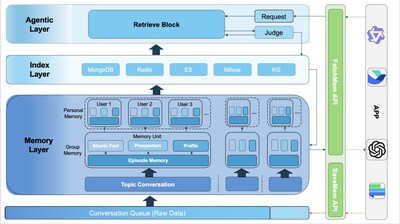Global Experiential Networking Market Report 2020-2025: Essential Support, Maintenance, and Training for Experiential Networking will Reach $42M Globally
Press Releases
Dec 17, 2020
DUBLIN, Dec. 17, 2020 /PRNewswire/ — The “Experiential Networking Market by Technology, Use Case, and Solutions 2020 – 2025” report has been added to ResearchAndMarkets.com’s offering.

This report investigates experiential networking market opportunities. The report evaluates companies anticipated to be influential in ENI as well as market positioning and strategies. It includes analysis by technology, use case, and solution. It also assesses experiential networking market opportunities by industry vertical. Quantitative analysis includes global and regional forecasts as well as by leading countries within each region for 2020 through 2025. The report also provides specific recommendations across the ICT and digital technology ecosystem relative to ENI.
Based on a European Telecommunications Standards Institute (ETSI) let initiative, experiential networking is a relatively new concept with ETSI forming an Industry Specification Group (ISG) focused on “Experiential Network Intelligence” (ENI) and holding an initial ISG ENI meeting in 2017. These efforts define an “observe-orient-decide-act” control model with the intent that networks will become increasingly more adaptive, supporting intelligent service operations by way of cognitive network management. Accordingly, the core of the experiential networking market is the use of Artificial Intelligence (AI) and cognitive computing.
More specifically, ENI will leverage data and contextual information (such as AI-based decision making) to take actions based on device and system-related events. Responses to events, related processes, and machine learning allows ENI to make automated decisions and provide recommendations for use by other systems such as management and orchestration platforms. This event-driven approach allows the experiential networking market to use various technologies to engage in intelligent analysis necessary for network and service policies and modeling.
This policy-based and model-driven approach to the experiential networking market means that data will be leveraged from many sources, and processed by disparate technologies, with a goal of simplifying complex device configuration and monitoring systems. This will also enable improved scalability for telecom and IT networking, which will be a boon for rapidly expanding Internet of Things (IoT) networks and systems as IoT becomes increasingly more voluminous and complex.
Like the Intent-Based Networking market for enterprise, ENI is focused on improving man-machine interaction for communications networks. A key goal of ENI is to automate network operations, which will have the effect of fewer errors as well as greater overall operational efficiency and effectiveness. Accordingly, the experiential networking market is intended to use a context-aware, meta-data approach to policy management that takes into consideration changes in user needs, environmental adaptation, and evolution of business goals.
To achieve these goals, proponents propose an ENI framework that takes into consideration policy management, data sources and the ability to leverage data learning, cognitive computing-based upon context-aware information, and interaction on an inter-system basis (e.g. communications and data sharing between different systems). This approach is intended to leverage available resources with several experiential networking market goals in mind including improving network planning and deployment, optimizing operations, and enhanced service orchestration and management.
More tangibly speaking, ENI is intended to de-risk Service Level Agreement (SLA) commitments by removing errors in key human-machine interfaces as well as automating important decision functions such as resource allocation and prioritization necessary to uphold SLAs in support of Quality of Service (QoS) and Quality of Experience (QoE) requirements. As previously mentioned, ENI will use a data-driven approach, using AI and data analytics for automated decision making. For instances requiring human interaction, the experiential networking market incorporates cognitive computing to enhance decision making. This can be important for delicate areas such as balancing network QoS with end-user QoE, which are sometimes mutually exclusive goals.
Use cases within the experiential networking market range from optimizing existing communications service provider applications to offering completely new business customer solutions focused on stringent QoS requirements. Many of these use cases will involve data and decision-making from many sources including the LTE and 5G RAN as well as core network capabilities such as network slicing. Networks will also benefit by including mobile edge computing infrastructure and systems. Specific use cases include intelligent carrier-managed SD-WAN, optimized 5G network slicing management, automatic address allocation for operation IP managed networks, and RF coverage and capacity optimization.
Target Audience:
- Managed services companies
- Systems integration companies
- Communication service providers
- ICT equipment and IaaS providers
- Operational support systems providers
Select Report Findings:
- Experiential networking relies upon a Publish/Subscribe Data Distribution Process
- Key supporting experiential networking technologies include AI and advanced data analytics
- Context-Aware Processing in experiential networking will become a $3.6B global market by 2025
- Essential Support, Maintenance, and Training for experiential networking will reach $42M globally by 2025
- North America will lead the experiential networking market followed by Asia Pac and Europe through 2025
Key Topics Covered:
1.0 Executive Summary
2.0 Overview
2.1 Research Objectives
2.2 Select Findings
3.0 Introduction
3.1 Experiential Network Management
3.1.1 Experiential Computing Systems
3.1.2 Augmented Intelligence
3.2 Network Types
3.3 Market Trends
3.4 Standardization
3.4.1 European Telecommunications Standards Institute
3.4.2 Experiential Networked Intelligence Industry Specification Group
4.0 Technologies Supporting Experiential Networking
4.1 AI and Cognitive Technologies
4.1.1 Deep Machine Learning
4.1.2 Context-Aware Processing
4.1.3 Artificial Neural Networks
4.1.4 Cognitive Computing
4.2 Experiential Solutions
4.2.1 Network Configuration and Traffic Management
4.2.2 Performance Monitoring and Management
4.2.3 Security Management
4.2.4 Network Device Management
4.2.5 Fault Management
4.2.6 IP Address Management
4.3 Telecom, Cloud Service Providers, and Enterprise
4.4 Traditional vs. IoT Networks
4.5 Public vs. Hybrid Cloud Deployment
4.6 Virtualization and Integration Service
4.7 Network Optimization and Orchestration
4.8 Standalone vs. Platform Solutions
4.9 SDN, NFV, Network Slicing, and Edge Computing
4.10 AI-Driven Network
4.11 Self-Driven Networks
4.12 Human-Machine Interaction
4.13 Communications Service Provider Experience
4.14 Data-Driven Network Management
4.15 Network Management Analytics
5.0 Company Analysis
5.1 Accedian
5.2 AppNeta
5.3 Aruba Network
5.4 Avaya Inc.
5.5 BMC Software
5.6 Broadcom (CA Technologies)
5.7 Cisco
5.8 Colasoft
5.9 Cubro
5.10 Compuware Corporation
5.11 Dell EMC
5.12 ExtraHop Networks
5.13 Extreme Networks
5.14 Flowmon Networks
5.15 HelpSystems
5.16 HPE
5.17 Huawei Technology
5.18 IBM
5.19 Ipswitch
5.20 Juniper Networks
5.21 Kaseya
5.22 Kentik
5.23 LiveAction
5.24 Zoho Corporation (ManageEngine)
5.25 Micro Focus
5.26 NETSCOUT
5.27 Nokia
5.28 Paessler
5.29 Riverbed Technology
5.30 SevOne
5.31 SolarWinds
5.32 VIAVI Solutions
6.0 Experiential Networking Market Analysis and Forecasts 2020 – 2025
6.1 Global Experiential Network Management Market 2020 – 2025
6.1.1 Total Global Market 2020 – 2025
6.1.2 Market by Segment 2020 – 2025
6.1.2.1 Market by Solution 2020 – 2025
6.1.2.2 Market by Solution Offering 2020 – 2025
6.1.2.3 Market by Service 2020 – 2025
6.1.3 Market by Technology 2020 – 2025
6.1.4 Market by Network Type 2020 – 2025
6.1.5 Market by Industry Vertical 2020 – 2025
6.1.5.1 Market by Service Provider 2020 – 2025
6.1.5.1.1 Market by Service Type 2020 – 2025
6.1.5.1.2 Market by Communications Network 2020 – 2025
6.1.6 Market by Network Platform 2020 – 2025
6.1.7 Market by Organization Type 2020 – 2025
6.1.8 Market by Deployment Type 2020 – 2025
6.2 Regional Experiential Network Management Market 2020 – 2025
7.0 Conclusions and Recommendations
For more information about this report visit https://www.researchandmarkets.com/r/wlg8lo
Research and Markets also offers Custom Research services providing focused, comprehensive and tailored research.
Media Contact:
Research and Markets
Laura Wood, Senior Manager
[email protected]
For E.S.T Office Hours Call +1-917-300-0470
For U.S./CAN Toll Free Call +1-800-526-8630
For GMT Office Hours Call +353-1-416-8900
U.S. Fax: 646-607-1904
Fax (outside U.S.): +353-1-481-1716
SOURCE Research and Markets



